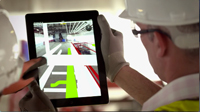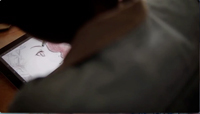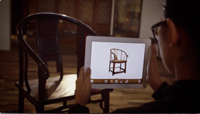Video Analysis: Life on iPad
The following post deconstructs a commercial video into its constituent parts in order to demonstrate the value of shot composure, sequence patterns and transition options for beginning to advanced videographers.The Full and Uninterrupted Video
The Producers
Life in iPad was produced in 2013 by Drea Cooper and Zack Canepari. This duo also produces the ongoing collective California is a Place.
Shots and Sequences
This visually stunning 2:00 video is shot at 24 fps. Its form is a series of vignettes, 28 very short scenes and sequences that quickly transition from one to the next, each markedly different from one another. The one item shared among all of the 28 scenes and sequences is the appearance of the product for which this video advertisement was created: the iPad. What is remarkable about this video is the variety of editing techniques employed to connect the vast array of video snapshots into one flowing and connected vignette. The editing techniques employ continuity: position continuity, movement continuity, and audio continuity.
The graph below reveals several interesting patterns that should be of interest to students of video production. Life on iPad is composed of 66 individual shots organized into 28 sequences. The average number of shots per sequence is 2.3. The longest sequences bookend the entire work; the beginning is 13 seconds in length, the final is 10 seconds. The first sequence also contains the most individual shots (7) suggesting careful development in establishing the opening visuals and mood of this work. Sequence three contains five shots, sequence nine contains four; every other sequence is composed of three or fewer individual shots. Six sequences contain only one shot.
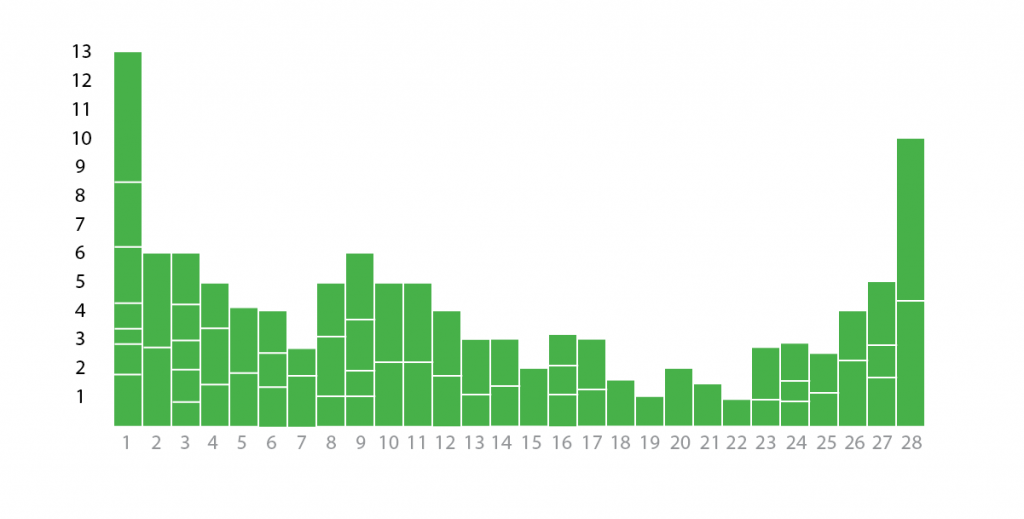
Sequence Patterns, Framing, and Continuity
Let’s breakdown individual sequences before we look at the producers use to match them together.

Videographers draw from a variety of visual techniques to open a video. Overt visuals may show doors opening, people greeting one another, the sun rising—things that suggest beginning.
Life on iPad begins, appropriately enough, with the push of a button. A machine is starting. After button push, the viewer sees gears being adjusted, a switch turned, gears coming alive, and the opening of a ceiling. Notice how connectedness and intentionality of these shots.
Sequence 1:

Final shot of the sequence is a breathtaking establishing shot that visually explains all shots that have preceded it. One effect that adds to the power of this shot is the zoom/ fly over effect. Lastly, note the beauty in the compositional elements of the frame: the repetition of (moving) shapes.
Audio
The Natural Sound (NATS) of the wind begins off screen, providing an audio opening for the video and preparing the viewer for the first shot. A second track of NATS is laid on top of the wind as the first shot begins. All sounds associated with starting the wind turbine remain matched to the visuals (as they were produced together originally in the camera). The sound of the machine fades out as the soundtrack fades in. The soundtrack bridges this sequence and the next.
Transition to Sequence 2


Sequence two begins with a medium over-the-shoulder shot that draws the viewers eyes, with the help of short depth of field, to words on an iPad screen: Fieldview. A finger operates the device and we see a change in tablet screen before the shot ends. The commercial is presenting different looks and different ways of using this product in brief moments. The second shot is a panning/ fly over of a arm machine reaping a corn field. Notice the sun is low in the sky, suggesting the morning hours. This second sequence, like the time of day, appears early in the video.
Sequence 2:
Audio
The soundtrack established in sequence 1 continues here. NATS from inside the cab plays until visuals cut to outside. Outside NATS plays through the shot and through the end of the sequence.

Transition to Sequence 3


Sequence three is composed of five shots. Opens with medium shot of a speed skater on ice. The skater is seen from the front and the dolly shot moves with the subject. Shot two frames the skater from behind and this new shot follows the subject.
Shot three is a wide flyover. Notice the shot movement is identical to the previous shot. Although the framing and angle are very different from the preceding shot, the similarity in movement make the transition between these shots seamless for the viewer.
Sequence 3:
Audio

Composed of three shots. The viewer sees the same treatment of repeating images because of an upheld iPad in the first shot. Shot 2 is a wonderful bird’s eye view of the twisting diver descending into the pool.
Sequence 4:

Audio
Transition to Sequence 5


Sequence five is composed of two shots. A “reveal shot” is normally defined by camera movement, such as when a camera is pulled back from the subject to reveal a wider scene. In this case, an explosion of bubbles fill the frame before revealing a wide over-the-shoulder shot of a diver and her iPad. The viewers eyes are drawn to the iPad because of this reveal and because the diver’s finger is pointing toward the object. Shot two puts the iPad in the same position on the screen and, because the viewer’s eyes are already there, the transition to the next shot feels seamless even though we now see a wide shot of the diver and sunken vessel from a different angle.
Sequence 5:
Audio
Transition to Sequence 6


Each of the three shots in sequence six are about a second in length each. As a result this sequence moves very quickly. The speed is heighten by the artificially heightened pace created for the first establishing shot of boats moving up a river and away from the viewer. The movement created by the last boat in shot one seems to carry over to the next shot, as if the viewer is now in that boat that slows as it passes the man at his iPad and handling vegetables. The third shot in this sequence is an over-the-shoulder that reveals the man’s iPad entries.
Sequence 6:
Audio
Transition to Sequence 7


Sequence seven also moves quickly; it is composed of two shots. The first shots swings into focus at the same angle and over the same shoulder as the last (in sequence six). The cook swipes the screen to reveal a photo of the finished meal. Shot two places the meal being cooked in exactly the same position on the screen. One more example of position continuity.
Sequence 7:
Audio
Transition to Sequence 8


Sequence eight is composed of three shots. The creative angle momentarily disorients the viewer before the flame bursts with wonderful energy and the hot air balloon is recognized. Cut to an establishing shot that features a majestic sweep of a sky and valley filled with balloons. Shot three is a tilt shot that immediately draws our attention to the iPad through framing and short depth of field. Not only are the balloons framed by the iPad itself, the figures in the forgrounds frame the tablet from two sides. Because the iPad is the only element in focus in this frame and our eyes are drawn to it.
Sequence 8:
Audio
Transition to Sequence 9


Sequence nine is composed of four shots. It opens with a close up of grapes on a vine before cutting to a second close up of grape leaves. Notice the matching horizontal lines in both of these shots.
Sequence 9:

The final shot is an establishing shot, made beautiful by the repetition of lines formed by the rows of vines.
Audio
Transition to Sequence 10


Sequence ten is the first of three two shot sequences in succession that take place within a vehicle. This sequence begins inside of a desert racing vehicle before we cut to a view from the outside rear as it lifts off the top of the hill into the air. The second shot begins in real time before lift off, which then slows for effect.
Sequence 10:
Audio
Transition to Sequence 11
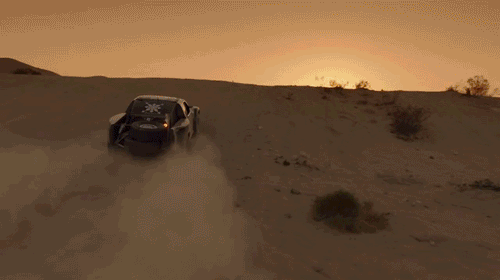

Like ten, sequence eleven begins inside of a vehicle, one that is not coincidentally in flight. The camera captures the flight movement from right to left, the same directional movement we experience in the next shot.
Audio
Let’s watch the second sequence again:

Unlike the previous two sequences that begin inside a vehicle and end by featuring it from the outside, sequence twelve reverses that two shot pattern by featuring a front shot of a firetruck on the street moving towards the camera before moving inside of the cab to show an over the shoulder shot from above the passenger seat. Worthy of note is the same degree of tilt in that second shot as in the aircraft sequence that preceded it.
Audio
Let’s watch the second sequence again:

Sequence thirteen is also composed of two shots. There should be little doubt that color plays a roll in the transition from the previous sequence. The viewer’s eyes leave the fire truck and are immediately drawn, from a birds eye view, to the principal dancer–wearing a bright red shirt– moving across the screen. Watch the color red move across the screen and land in the next shot:
Audio
Let’s watch that sequence again:

Sequence fourteen is the last of the five in the series of two shot sequences. The first shot is a medium shot that pans from left to right. Just before the shot ends, the surgeon farthest from the camera and nearest the iPad is revealed. Cut to a close up of that same surgeon.

Audio
Let’s watch that sequence again:

Sequence sixteen is composed of three shots. The first shots a close up that cuts to a wide. The continuity is not perfect because the position of the girls has changed, but the immediate release of the water rocket distracts the viewer from noticing.

Audio
Let’s watch that sequence again:

Sequence seventeen is composed of two shots, the first of which is a medium in which the subjects face the viewer. Because shot two is so visually different from the first (subjects have left the frame and viewer is now looking over the shoulders in this close up of the iPad), the editor uses motion to link the reverse angle into one sequence:

Audio
Let’s watch that sequence again:
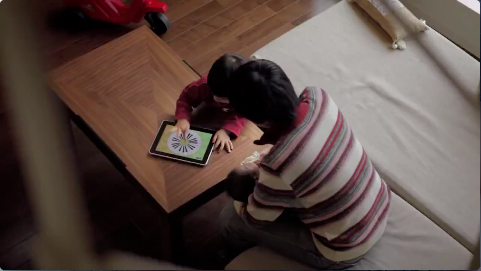
Sequence twenty two is the fifth of five in a series of single shot sequences. As in the preceding sequences, an over the shoulder shot is featured. Worthy of note is the fact this series of single shot sequences begins with an extreme close up and, with each succeeding shot, the camera moves farther away from the subject(s).
Audio 
Let’s watch that sequence again:

Sequence twenty four is composed of three shots. The first shot features a close up of an iPad whose function is set in motion with a finger pushing a record button on the app. Guitar strumming begins with the next shot–it’s a close up of a drummer. The audio finds a home in the third and final shot of this sequence as a medium shot of a band appears with a guitar player strumming. This is an example of sound continuity.
Audio
Let’s watch that sequence again:

Sequence twenty six is composed of two shots. The matching cut is an effective blend of movement continuity and position continuity. The continuous movement is the approaching pan shot that wraps around the man into an over the shoulder shot. Because the man is in the foreground, he is appears to move most in the frame and the viewers eyes are drawn to the iPad. At the moment the man’s head blocks our view of the tablet from the left, the cut fast forwards to a close up over the shoulder on the man’s right. Although the cut registers in the mind of the viewer, satisfaction results from our ability to maintain visual contact with the image on the iPad in addition to approaching closer to the device.
Audio
Let’s watch that sequence again:

Sequence twenty eight–the final sequence–is ten full seconds in length. It is composed of two shots, a medium shot of a mountain climber looking at an iPad in a tent anchored to the side of a cliff. The camera pulls away in a comparatively lengthy shot before the final cut has carried the viewer back into an extreme long shot, arguably as breathtaking as the shot of the wind turbines in the opening sequence. Snow covered mountain cliffs fade to white.
Audio
Let’s watch that final sequence again:
Exercise: Linking Sequences Through Continuity
The previous section has addressed frame composition and continuity within sequences. The following section presents opportunities for students to recognized continuity strategies that link unlike sequences together. Print the handout below and examine each of the isolated transitions between sequences in order to determine continuity methods














